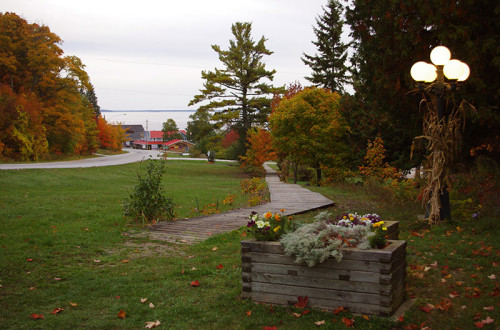CENTRAL MANITOULIN – An online public consultation meeting held Wednesday, September 30 via video conferencing software has resulted in a Central Manitoulin council decision to re-open both the J.H Burt Memorial Arena in Mindemoya and the Providence Bay War Memorial Community Arena.
A controversial recommendation from the municipality’s property committee to only open the Providence Bay facility was defeated at the September 24 meeting of council following a delegation presentation by Mindemoya Thunder Minor Hockey Association president Brian Phelps in which he pointed out the lack of consultation that had taken place before the recommendation was made.
Although at least half of council had supported the committee decision during debate following the presentation; the lack of community consultation did strike a nerve with councillors who defeated the motion to only open the Providence Bay arena and voted to hold a public consultation via video conferencing.
In remarks at the conclusion of the public meeting, Councillor Dale Scott pointed out that committee meetings only consist of five councillors, at most, and that recommendations to council are not decisions of council as a whole. He reiterated that the motion to only open the Providence Bay arena was defeated when it came to the council table.
The public meeting heard delegations from Adam Smith, president of the Mindemoya Minor Hockey Association; Dan Charette, a former chair of the (now-disbanded) Mindemoya Arena Advisory Committee; Greg Lockeyer, in his volunteer role as District 7 Minor Hockey officials (timekeepers and referees) representative; Michael Bridgeman, hockey coach; Janet Anning, Manitoulin Special Olympics community co-ordinator; and Maja Mielonen, ballet teacher and local cycling advocate.
Mayor Richard Stephens opened the meeting with a short synopsis of the process to date and noted that all of the council members had received “a healthy number of emails and phone calls” on the issue. Mayor Stephens thanked the municipal staff for their efforts and for facilitating a tour of the arenas in Central Manitoulin.
Mr. Smith spoke first, and at length, on the importance of keeping the Mindemoya arena open. He noted the surprise with which the news of a potential closure was greeted in the community and provided numbers on registrations for the upcoming hockey season—62 confirmed and five to 10 potentials. He suggested the number of registrations was likely to reach 87, but was certain to be in the 62 to 72 range.
Mr. Smith went on to point out that the smaller size of the Providence Bay ice surface, and the building overall, flies in the face of Hockey Canada recommendations on physical distancing. The Providence Bay ice surface is 13 percent smaller than that of Mindemoya, but of somewhat greater concern is that the ice surface is 30 percent smaller than the norm, with a whopping 37 percent difference between the regulation-size ice surface in Little Current and that of Providence Bay.
“When you are looking social distancing that makes a pretty big difference,” Mr. Smith said. “COVID has changed how the world operates.”
The recommended distance to be maintained between players on the ice is a full hockey stick.
“We do not wish to see either arena closed,” said Mr. Smith.
He pointed out that the municipality had received $215,000 to mitigate expenses related to the pandemic which could go a long way toward keeping both facilities open.
Mr. Smith pointed to the need for a clear plan going forward and cited his organization’s willingness to live with the Providence Bay arena for a year while the new multiplex was being constructed to replace the Mindemoya arena. A clear plan to fix the Mindemoya arena might soften the association’s stance and he noted there is a $503,000 reserve to cover those costs that might be added to every year to move toward a more permanent solution with “a new facility down the road.”
Mr. Charette said he is experiencing a sense of déjà vu in the debate that has reoccurred a number of times since amalgamation as arena closures seem to be considered a low-hanging fruit for successive councils, but that support remains for maintaining four fire halls and community centres. “Arenas are an easy target,” he said, especially given their cost of maintenance, but “we have to look at the benefits they bring to our community.”
Mr. Lockeyer stressed the health and safety of hockey officials in his presentation, noting that his concerns were not linked to the location of each arena, but rather to the size of the ice surfaces involved. “If the Providence Bay arena had the larger ice surface and Mindemoya was to be opened I would be here with the same concerns,” he said. But he did point out that the Providence Bay arena would involve greater costs for the minor hockey associations due to mileage and travel costs.
He pointed out that the upcoming hockey season was to proceed with a three-on-three format. Referees were instructed to call penalties if players came within a stick length of another player, unless that player had the puck. “This is why the smaller ice surface makes no sense,” he said. “Thirteen percent is a big difference,” he said of the ice surface. “Especially when trying to maintain the optimum distance.”
Mr. Bridgeman noted that most of the points he wished to bring to council’s attention had already been covered by previous presenters, but he wished to speak of the plight of youth in the community. “They have had so much taken away from them this year,” he said. “Our kids don’t have many avenues; they are very limited in what they can do.” He also pointed out that the Mindemoya arena has four times the amount of usage seen by the Providence Bay facility.
Ms. Anning spoke about the important role the Mindemoya arena plays in the Manitoulin Special Olympics’ annual softball tournament, particularly since the adjacent community hall in Mindemoya is not fully accessible. The softball tournament was cancelled for this year, but should the Mindemoya arena remain closed through next summer, it would severely hamper her organization’s planning for 2021.
She also noted that the Providence Bay facility plays an important role in the annual Bluegrass in the Country festival that functions as Manitoulin Special Olympics’ main fundraiser.
Ms. Anning pointed out that there are more interests in the arenas than just hockey players and their families.
Ms. Mielonen brought forward concerns regarding the farmers’ market and her own challenges as a ballet teacher. While she agreed that the expense involved in keeping the arenas open impacted taxes and in turn the viability of businesses in the community, and that keeping only one arena open was a sensible exercise in fiscal responsibility, she made the argument that keeping the Mindemoya arena open makes the most community sense—floating the idea of selling the Providence Bay arena to the agricultural society board.
“I would like to see a clear vision,” she said. “I would encourage council to think of the big picture.”
The meeting then moved to an open mic format to allow councillors to ask questions and seek additional information from the presenters.
In the ensuing discussion it was revealed that the Mindemoya arena footprint was 17,000 square feet in size, while the Providence Bay facility was only 10,750 square feet. Mayor Stephens expressed surprise at that information, saying “I had no idea.”
After some discussion on the proposed timing of the opening it was revealed that the Mindemoya Thunder would not object to ice being available by October 30 and that their season operations would start November 1.
It was questioned whether the motion to keep both facilities open was necessary, as that would essentially be the status quo, but CAO Ruth Frawley suggested a motion would provide clarity for staff and the community.
In a polled vote only Councillor Stephens voted against the motion, with councillors Scott, Tribinevicius, Johnston, Diebolt, Shaffer and Mayor Stephens voting in favour to carry the motion.
Going forward, both the Mindemoya and Providence Bay arenas will open for the 2020-2021 season.





